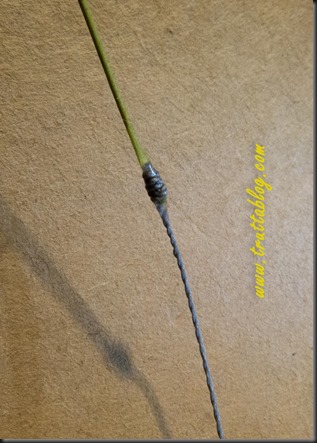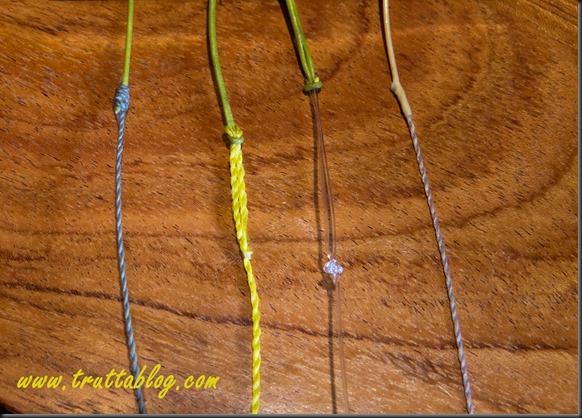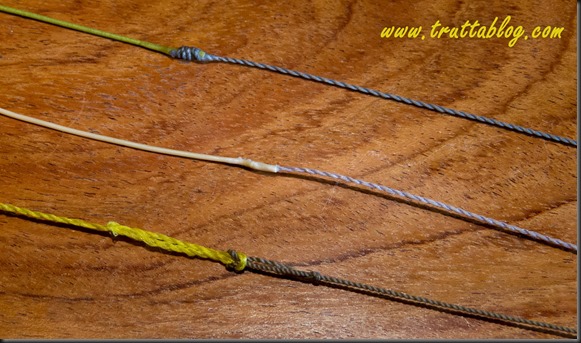The method one uses to connect your fly line to your leader, has been a topic of discussion for a long time.
It might be true to say that most flyfishers use a loop to loop connection. This preference is fuelled by the fact that most fly lines now come with a welded loop on the end. This certainly is an easy and versatile way of going about things. It is very easy to change your entire leader at any time.
The downside is bulk and “catchiness”. By that I mean that a loop to loop connection, and in particular one involving the thick butt end of a nylon or co-polymer tapered leader, is a particularly visible thing, as well as something that catches in the tip eye of your rod at that worrying moment when you are trying to land a wildly bucking trout of pleasing proportions.
So it is that many people have been quick to cut the loop off the end of their fly line, and replace it with either a nail, or needle knot, or superglue splice. Those are much neater.
Problem solved.
Except that the join is permanent. So you don’t get to switch leaders at the drop of a hat. And what if, like me, you are rather partial to furled leaders?
Furled leaders come with a loop in the end. That is in their very nature….the way in which they are manufactured dictates that there will always be a loop in the thick end. The other thing about them, is that they are inclined to become waterlogged and need changing out. As a result, I have often retained the welded loop on my fly line, but have done so almost grudgingly, and with a faint notion that there must be a better way.
With this drought going on, there has been plenty opportunity to stay home and tinker.
So here’s what I thought:
Instead of an amadou patch, I have taken to drying my flies by squeezing them between forefinger and thumb in a fold in my “wicking fabric” fishing shirt. It is hugely effective, and I don’t need amadou. One less thing to dangle from your vest. I recently tried drying my furled leader by drawing it across my side, or across my knee wearing pants of similar material. It was superb. Very effective indeed. If I do it just as I take a break for sarmies, and then leave the rod strung up in the sun, I can apply paste after I have eaten, and I am good to float for the rest of the day.
So with the new found freedom of being able to leave a furled leader on almost permanently I tried this:
A furled leader connected by nail knot
But then I got to thinking about a superglue splice knot using a furled leader.
Now, if you don’t mind me saying so, we are cooking with gas!
Some details:
Firstly, if you are not familiar with a superglue splice or needle knot, it would be best to watch this first.
I was limited in that I could not use a furled leader manufactured with a tippet ring in it (picture a mouse giving birth to an elephant). But my own furled leaders don’t have that problem. Then the improved clinch knot with which I tie the start of the tippet onto the fine end of the furled leader, was too rough to go through the line too. I solved that by cutting it off, looping some 5X through the fine end, and pulling that into the side of the fly line and down out the end….twice…and then with that loop, pulling the fine end of the furled leader into the side of the fly line. Pulling the whole furled leader through was quite tough, but it worked. When it came to the superglueing of the last inch of furled leader into the line, the furled leader gave me a good absorbent base, which sucked up glue, and then stuck particularly well. I really struggled to break it, applying perhaps 20 Kg of force before it gave way. Strong enough for me!
So here is a comparison of some options:
Left to right: A nail-knot with UV glue covering; a loop to loop with a furled leader; a loop to loop with a nylon leader; the furled leader nail knot.
Another idea has also occurred to me: One could pull a furled leader backwards into the end of the fly line. I know, that sounds dumb, but hear me out. That would give you a furled leader loop a few inches off the end of the fly-line. You could then change furled leaders using a loop to loop. Yes ..I know…loop to loop…but the thing is, that the bulkiness of this arrangement lies primarily in the large knot formed in the nylon (even if you do a perfection loop…see the picture above). Thicker nylon is in fact horribly “catchy” when tied in a loop, and in my view should be avoided all together. A furled leader loop does not have this hard “catchy” knot, and despite its apparent bulk, slides through the end guide of the rod with the greatest of ease.
So there you have it….some ideas to play around with if, like me, you are a bit of a nut for furled leaders.




6 Responses
Dear Andrew,
As this 2015 train is almost at the station, I want to wish you and your family a fantastic and very prosperous 2016. May the fly fishing trips be many and the business dollars be rolling in.
Your book is a beauty. I’ve finished reading it and my wife is reading it now. Really enjoyed it and learned al lot about fly fishing in general.
Your latest post on Truttablog really grabbed me. I’ve been reading about furled leaders for a long time and about the jigs you have to build to make them. Really interested. Now, I’ve got a lot of questions about the why, where, when, what and how. If and when you got the time, I’ll appreciate it if you could share some your knowledge with me.
Thank you very much.
Kind regards,
3s Ellis It is better to burn out than to fade away.
>
Thanks Dries, and same to you for 2016. Glad you are enjoying the book! I would be more than happy to pass on to you everything that Darrel Martin taught me about furled leaders.
Pretty impressive Andrew! I have always done either loop to loop or nailknotted and superglue. Now you’ve got me thinking. Good post! Happy New Year my friend!
And a happy 2016 to you too Howard! Glad to have spurred some thoughts. Always good to tinker with ones tackle and see if there isn’t perhaps a better way.
Why not to use fly line core to form a loop?
No extra material needed. Consistent and extra strong.
Thanks Mac, Yes….some lines have a core that you can use like this….but not all. The knot can also stick, depending on the thickness and loop or knot used. Coating the knot with UV Knotsense can hep too.